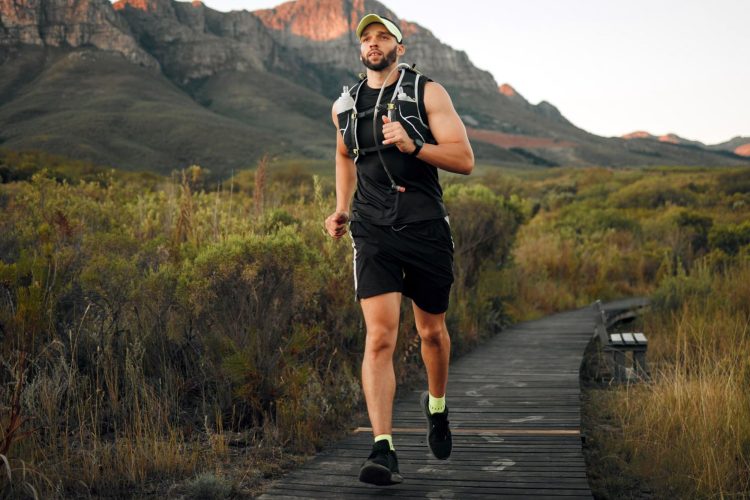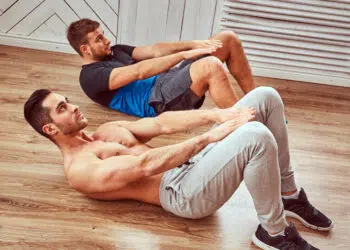Walking is probably the most common fitness activity in the world. Certainly, it’s the most popular in the United States (1). There are several reasons for this, including:
- Accessibility
- Convenience
- Effective
- Enjoyable
- Low injury risk
- No special skills required
- Suitable for all levels of exerciser
Like all forms of exercise, walking is incredibly good for your health, and research published on PubMed suggests that people who walk regularly live longer, healthier lives (2). However, while the benefits of walking are undeniable, some people prefer a more demanding workout, such as running.
Running typically raises your heart rate more than walking and burns more calories per minute. Consequently, some exercisers feel they must graduate to running once walking starts to feel easy. After all, harder workouts are better workouts, right? Read more about Walking vs. Running for weight loss.
Unfortunately, while running can provide an effective workout, it’s not for everyone. Running is a high-impact activity that may be unsuitable for older and overweight exercisers. It’s no coincidence that as many as 40% of runners experience some form of injury (3).
As a personal trainer with over 30 years of experience, it’s my job to help people get fit, lose weight, and improve their health. It’s also my job to minimize any risk of injury. Consequently, I often prescribe walking instead of running to my clients.
In my opinion, walking provides all the benefits of running and none of the drawbacks. In fact, having walked 10,000 steps a day for well over a year, I can categorically say that you can get in great shape weight without ever running a step.
Level Up Your Fitness: Join our 💪 strong community in Fitness Volt Newsletter. Get daily inspiration, expert-backed workouts, nutrition tips, the latest in strength sports, and the support you need to reach your goals. Subscribe for free!
In this article, I share three of my favorite walking workouts, each of which will tone your legs, build fitness, and burn serious calories!
Walking Workout #1 – Interval Walking
Walking at a steady pace is an excellent way to build basic aerobic fitness, and working up to 10,000 steps per day will do wonders for your health, too. However, to get fitter and burn more calories, you must increase your pace and work your heart and lungs a little harder.
On the downside, walking at a brisk pace may mean you are unable to walk as far, potentially making your workout less effective. I know, it’s a conundrum!
One way to overcome this problem is with interval training.
Interval training is a type of workout where you alternate between short periods of intense exercise with brief recoveries. This raises the average speed and intensity of your workout without necessarily affecting the overall duration. The result is that you’ll burn more calories and develop a higher fitness level compared to exercising at a constant pace (4).
Interval training is typically associated with athletes and other experienced, well-conditioned exercisers. However, it’s also a great way to make walking even better for fitness, toning, and kilocalorie burning.
Before you start any of these sessions, please ensure you prepare your body with a short warm-up. A few minutes of light walking followed by some pre-activity stretches will suffice. Also, feel free to modify these programs to match your current fitness level.
Interval Walking Workout Plan
Here is an eight-week interval walking plan designed to improve fitness, burn fat, and tone your legs. It’s progressive, so each week is a little more demanding than the last. Do each workout 2-4 times per week, but only move onto the next level if you feel ready.
Regarding pace, it’s up to you to determine how fast you walk. Walking speeds are often described in terms of miles per hour (MPH), i.e.,
- Slow: 2.5 MPH
- Casual: 3 MPH
- Brisk: 3.50 MPH
- Fast: 4 MPH
That said, these speeds may not be suitable for everyone. Instead, slow walking should feel easy, while fast walking should be challenging but sustainable. Provided there is a noticeable difference between your slow and fast pace, you’ll be good to go.
| Week | Slow | Fast | Repeats | Total Duration |
| 1 | 5 | 1 | 4 | 25 minutes |
| 2 | 4 | 2 | 4 | 24 minutes |
| 3 | 3 | 3 | 5 | 30 minutes |
| 4 | 2 | 4 | 5 | 30 minutes |
| 5 | 1 | 5 | 6 | 36 minutes |
| 6 | 1 | 6 | 6 | 42 minutes |
| 7 | 1 | 7 | 7 | 49 minutes |
| 8 | 1 | 8 | 8 | 56 minutes |
So, for week one, walk slowly for five minutes, quickly for one minute, and repeat four times to total 25 minutes.
Walking Workout #2 – Weighted Vest Walk
Walking is a great lower-body workout. The simple act of putting one foot in front of the other will tone all your leg muscles, from your calves to your quads to your hamstrings to your glutes. Walking also strengthens your joints and bones.
However, PubMed research suggests that wearing a weighted vest makes walking even better for burning kilocalories, increasing bone density, and developing lower body strength (5). In short, it supercharges your walks, making them more effective and efficient.
Simply put, wearing a weighted vest means your body has to work harder. How much depends on several factors, including the weight of the vest and walking speed, duration, and terrain. I’ve found that wearing a weighted vest means I can get my heart rate up to 70-80% of my maximum without breaking into a run.
Related:
Level Up Your Fitness: Join our 💪 strong community in Fitness Volt Newsletter. Get daily inspiration, expert-backed workouts, nutrition tips, the latest in strength sports, and the support you need to reach your goals. Subscribe for free!
- 10 Best Weighted Vests to Up Your Training Intensity
- 8 Best Women’s Weighted Vests Reviewed
- Best Weighted Vest Exercises and Workouts for Next-Level Bodyweight Training
Weighted Vest Walking Workout Plan
While you could just strap on your weighted vest and start walking, going too heavy too soon can lead to injuries. This six-week plan is designed to gradually raise the weight of your vest and increase how far you walk, easing you into this type of training.
Do each workout 2-4 times per week, but only move onto the next level if you feel ready. Walk at a pace that feels challenging but sustainable for the prescribed duration. As always, make sure you warm up before you begin with some easy walking and appropriate stretches.
| Week | Weight* | Distance |
| 1 | 5% | 2 miles |
| 2 | 5% | 2.5 miles |
| 3 | 7.5% | 2.5 miles |
| 4 | 7.5% | 3 miles |
| 5 | 10% | 3 miles |
| 6 | 10% | 3.5 miles |
*Load your weighted vest with the specified percentage of your body weight. So, if you weigh 150 pounds, load your vest with around 7.5 pounds.
Walking Workout #3 – Endurance Hike
I believe any walk is a good walk, and I look for opportunities to walk as often as possible. For example, I walk to the local grocery store instead of driving, walk around the gym between exercises and sets, and make sure I walk my dogs every morning before I start work. This makes it much easier to accumulate my target of 10,000 steps per day.
And while this sort of incidental walking is hugely beneficial, it can be a little. Consequently, whenever possible, I pack up and head out to walk in nature. In other words, I go hiking.
Hiking in the great outdoors offers many benefits, including (6):
- Increased vitamin D production from sunlight exposure
- Enhanced respiratory health due to fresh air
- Boosted immune system from exposure to natural elements
- Enhanced balance, agility, and coordination
- Improved sleep quality
- Reduced stress levels and improved mood
- Enhanced sense of well-being and happiness
- Decreased symptoms of anxiety and depression
- Increased self-esteem and confidence
- Enhanced cognitive function and concentration
- Boosted creativity and problem-solving skills
- Increased feelings of relaxation and rejuvenation
- Increased mindfulness and appreciation for nature
Needless to say, some of these benefits are NOT associated with walking on a treadmill (or should that be dreadmill, am I right?!).
Physically, hiking combines the benefits of our two previous workouts. The variations in terrain provide something like the walking interval workout. In contrast, carrying food, water, and other supplies in your backpack means it’s also a weighted workout. You can also enjoy some incredible scenery and clean, fresh air.
Related: Outdoor Workouts for Every Season: Staying Fit in Nature
Endurance Hike Workout Plan
For this workout, I want you to take your walk in an area where nature is abundant. Places to consider include:
- National Parks
- State Parks
- National Forests
- Wilderness Areas
- Wildlife Refuges
- Coastal Areas
- Bureau of Land Management (BLM) Lands
- Regional Parks
Next, use a map or app and plan your route. Make sure you consider your fitness and experience and don’t take on anything too arduous too soon. Four to six miles on a well-marked trail is a suitable place to start for most reasonably fit novice hikers.
Then, prepare your equipment and load it into a backpack. Make sure you have plenty of water, snacks, a first aid kit, maps, a fully-charged phone, a flashlight, a signaling whistle, spare clothing, and any other essentials.
Clothing-wise, you should dress according to the weather and with respect to the elements. A wide-brimmed hat and sunscreen are essential for summer hiking, while you may need a waterproof jacket, gloves, and a warm beanie during the colder months. Boots or sturdy hiking shoes are also a must.
Finally, head out on your hike and enjoy the experience!
Walk at a comfortable place to avoid getting too tired too soon. Stop every hour or so for a rest and to rehydrate and refuel. Be mindful and pay attention to the sights, sounds, and smells around you, remembering that the benefits of hiking are as much mental as physical.
Assuming all went well, you can plan your next hike to be a little longer or more arduous, e.g., more elevation or rougher terrain. You can even work up to multi-day hikes, where you camp overnight.
Closing Thoughts
Many fitness experts undervalue walking. They say it’s too easy to be effective and that more intense workouts are the only way to get fit, burn fat, and tone up.
How wrong they are!
Walking is one of the most potent workouts around, and the fact you can do it every day is a big part of the reason it’s so valuable. Try doing HIIT every day for a year, and then tell me how you feel. Pretty beat up, I bet.
In contrast, walking every day will do you nothing but good. As I like to tell my clients, walking is big medicine.
So, while there is nothing wrong with running, it’s not compulsory, and you don’t have to run to get fit, tone up, and lose weight. Instead, you can walk your way to fitness and health.
Related: How to Walk for Fitness and Fat Loss – Your Ultimate Guide
References:
- US Bureau Of Labor Statistics: Sports And Exercise Among Americans.
- Nagai M, Kuriyama S, Kakizaki M, Ohmori-Matsuda K, Sone T, Hozawa A, Kawado M, Hashimoto S, Tsuji I. Impact of walking on life expectancy and lifetime medical expenditure: the Ohsaki Cohort Study. BMJ Open. 2011 Jan 1;1(2):e000240. doi: 10.1156/bmjopen-2011-000240. PMID: 22021866; PMCID: PMC3191604.
- Kakouris N, Yener N, Fong DTP. A systematic review of running-related musculoskeletal injuries in runners. J Sport Health Sci. 2021 Sep;10(5):516-522. doi: 10.1016/j.jshs.2021.04.001. Epub 2021 Apr 20. PMID: 33862272; PMCID: PMC8500811.
- Foster C, Farland CV, Guidotti F, Harbin M, Roberts B, Schuette J, Tuuri A, Doberstein ST, Porcari JP. The Effects of High-Intensity Interval Training vs Steady State Training on Aerobic and Anaerobic Capacity. J Sports Sci Med. 2015 Nov 24;14(4):747-55. PMID: 26664271; PMCID: PMC4657417.
- Puthoff ML, Darter BJ, Nielsen DH, Yack HJ. The effect of weighted vest walking on metabolic responses and ground reaction forces. Med Sci Sports Exerc. 2006 Apr;58(4):746-52. doi: 10.1249/01.mss.0000210198.79705.19. PMID: 16679992.
- Gladwell VF, Brown DK, Wood C, Sandercock GR, Barton JL. The great outdoors: how a green exercise environment can benefit all. Extrem Physiol Med. 2014 Jan; 2(1):6. doi: 10.1186/2046-7648-2-3. PMID: 23849478; PMCID: PMC3710158.











